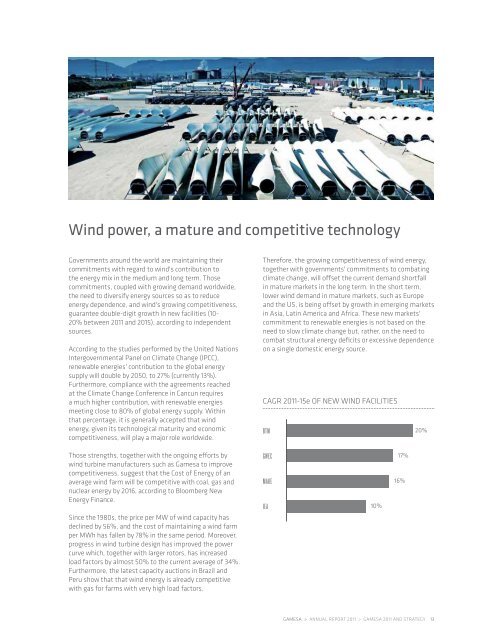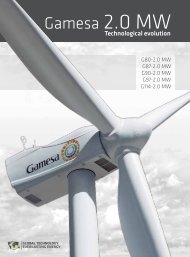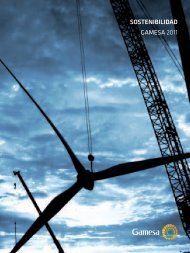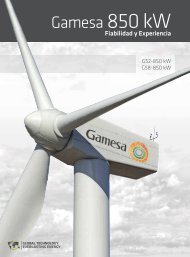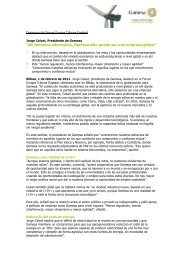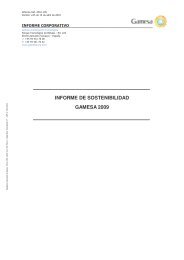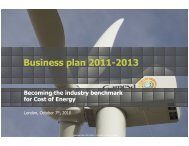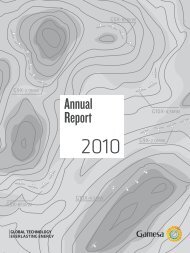Summary Annual Report 2011 - Gamesa
Summary Annual Report 2011 - Gamesa
Summary Annual Report 2011 - Gamesa
You also want an ePaper? Increase the reach of your titles
YUMPU automatically turns print PDFs into web optimized ePapers that Google loves.
Wind power, a mature and competitive technology<br />
Governments around the world are maintaining their<br />
commitments with regard to wind's contribution to<br />
the energy mix in the medium and long term. those<br />
commitments, coupled with growing demand worldwide,<br />
the need to diversify energy sources so as to reduce<br />
energy dependence, and wind's growing competitiveness,<br />
guarantee double-digit growth in new facilities (10-<br />
20% between <strong>2011</strong> and 2015), according to independent<br />
sources.<br />
according to the studies performed by the united nations<br />
intergovernmental panel on climate change (ipcc),<br />
renewable energies' contribution to the global energy<br />
supply will double by 2050, to 27% (currently 13%).<br />
furthermore, compliance with the agreements reached<br />
at the climate change conference in cancun requires<br />
a much higher contribution, with renewable energies<br />
meeting close to 80% of global energy supply. Within<br />
that percentage, it is generally accepted that wind<br />
energy, given its technological maturity and economic<br />
competitiveness, will play a major role worldwide.<br />
those strengths, together with the ongoing efforts by<br />
wind turbine manufacturers such as <strong>Gamesa</strong> to improve<br />
competitiveness, suggest that the cost of energy of an<br />
average wind farm will be competitive with coal, gas and<br />
nuclear energy by 2016, according to Bloomberg new<br />
energy finance.<br />
since the 1980s, the price per mW of wind capacity has<br />
declined by 56%, and the cost of maintaining a wind farm<br />
per mWh has fallen by 78% in the same period. moreover,<br />
progress in wind turbine design has improved the power<br />
curve which, together with larger rotors, has increased<br />
load factors by almost 50% to the current average of 34%.<br />
furthermore, the latest capacity auctions in Brazil and<br />
peru show that that wind energy is already competitive<br />
with gas for farms with very high load factors.<br />
therefore, the growing competitiveness of wind energy,<br />
together with governments' commitments to combating<br />
climate change, will offset the current demand shortfall<br />
in mature markets in the long term. in the short term,<br />
lower wind demand in mature markets, such as europe<br />
and the us, is being offset by growth in emerging markets<br />
in asia, latin america and africa. these new markets'<br />
commitment to renewable energies is not based on the<br />
need to slow climate change but, rather, on the need to<br />
combat structural energy deficits or excessive dependence<br />
on a single domestic energy source.<br />
caGr <strong>2011</strong>-15e of neW WinD facilities<br />
BTm<br />
GWec<br />
maKe<br />
iea<br />
10%<br />
17%<br />
16%<br />
20%<br />
<strong>Gamesa</strong> > annual report <strong>2011</strong> > <strong>Gamesa</strong> <strong>2011</strong> anD strateGy 13


